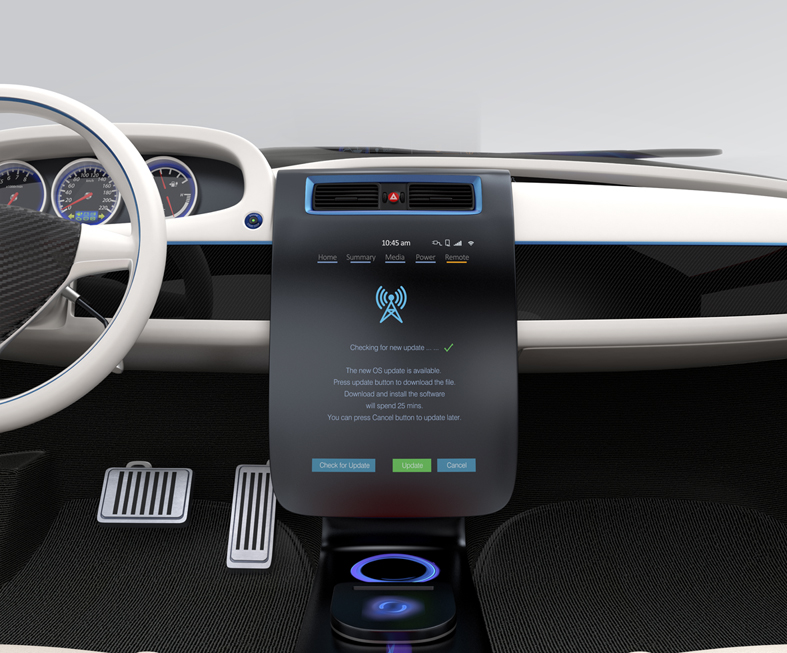



Feature Story
More feature stories by year:
2024
2023
2022
2021
2020
2019
2018
2017
2016
2015
2014
2013
2012
2011
2010
2009
2008
2007
2006
2005
2004
2003
2002
2001
2000
1999
1998
![]() Return to: 2015 Feature Stories
Return to: 2015 Feature Stories
CLIENT: IMAGINATION TECHNOLOGIES
Dec. 22, 2015: IEEE Computing Now
by Volker Politz, VP of Segment Marketing, Imagination Technologies

We live in what will perhaps be considered by historians as the golden age of technology. Innovations are happening at breakneck speed, and so are its mass adoptions. As we wrap up 2015 and look at what lies ahead, it is clear that our voracious appetite for content and the need for constant connectivity are only going to escalate. So in 2016 we will see a continued drumbeat for technologies that enhance the broader adoption of IoT, over-the-top (OTT) content, connected homes, smart cars and solutions that deliver rich content.
Today IoT is a highly fragmented market. Be it a smart home, connected neighborhood or smart city, various standards organizations have been trying to push their technologies to the forefront. In 2016, some of these standards bodies that are trying to tackle similar challenges will begin to coalesce, and we are already seeing telltale signs of such trends. Earlier this year we saw standards bodies like the ZigBee Alliance and the Thread Group announce a collaboration to enable interoperability and streamline product development. Recently, the Open Interconnect Consortium (OIC) expanded its presence in the smart home market with the acquisition of the UPnP Forum, which was founded to maintain peer-to-peer connectivity protocols. In this evolving market crowded with standards bodies, organizations like the AllSeen Alliance, prpl Foundation, the Thread Group and many others are hard at work in solving interoperability, security, connectivity challenges and more.
Even as the IoT market is beginning to take off, it is clear that security is its weakest link. In 2015 we heard of several cases of homes being hacked into and people's privacy invaded through simple baby monitoring devices that were connected to the internet. Today, consumers are wary of connected devices. But that will not stop everyday gadgets like smoke alarms, security systems and home appliances from going online. What is needed are low-cost microprocessors that can enable security at the hardware level in these products – solutions that not only thwart hackers compromising the system, but also ensure that the software running on these processors is fully authenticated and exactly the version intended.
In 2016 we can anticipate the creation of government regulations worldwide around privacy, access to content and the need for automatic software updates to ensure security of nation states. Hence IoT devices that do not come with at least a basic level of over-the-air (OTA) software patching features will fail to accommodate and adapt to these changing requirements, resulting in earlier than expected device replacements and other costly implications.
One of the biggest technology trends in 2015 was the rising popularity of over-the-top (OTT) content among consumers. This market, which started off with OTT pioneers like as LoveFilm and Joost who delivered streaming content over eight years ago, has now gained traction with the grand success of the Netflix original series, the "House of Cards" and numerous other shows from providers like HBO, Showtime, CBS and others. In fact this trend of delivering premium entertainment content over the internet versus traditional broadcast methods is expected to grow exponentially. According to Digital TV Research, the worldwide over-the-top TV and video revenue will reach $51.1 billion in 2020, nearly doubling the $26.0 billion expected in 2015. This is in part driven by Netflix's global expansion.
China will grow to $2.815 billion in 2020 (up from just $40 million in 2010), elevating it to the fourth-largest OTT market by that time. The State Administration of Press, Publication, Radio, Film and Television of the People's Republic of China (SAPPRFT) is beginning to regulate the specifications and security mechanisms mandated in hardware. As a result we will see more Chinese SoC companies like Allwinner, Actions, Rockchip and others trying to gain a larger stake in the OTT box market. In 2016 we will also see the evolution of OTT products moving away from simply streaming movies and short-form content to including downloadable games and apps on streaming devices, which are gaining popularity. This will place additional demands on the SoCs within OTT streaming products, creating demand for increased CPU and GPU performance.
So what do these changes mean for technology providers? For several years now TV manufacturers have been talking about 4K television that can deliver superior quality pictures. But now with studios and OTT providers coming on board to deliver 4K streaming content over the Internet and unencumbered by broadcast transmission standards, the 4K TV market is finally poised to take off.

Amazon Prime Instant Video is a forerunner in the push towards high dynamic range (HDR) video streaming content. HDR has become one of the crucial technologies in the quest for next-generation 4K content. Unlike its predecessor - first generation 4K ultra HD video - HDR is capable of delivering a superior level of color depth and improved visual clarity. With its wider color gamut delivering greater depth in shadows and contrast, HDR can make HDTV content look far more visually arresting than standard ultra HD video.
But the HDR market still needs standardization and that is another battle we will see played out in 2016. There are several contenders in this market space including Dolby Vision, Technicolor, the UHD Alliance and individual TV makers like Samsung, Sony, Panasonic and LG who all offer their own flavors of HDR.
In the connected home, the battle for leadership continues to intensify. On one hand we will see smart TV manufacturers making a greater push for the TV to be the main point of interaction and aggregation for the connected home. According to IHS Technology, smart TVs running in customer homes globally will leap from 174 million units in 2014 to 716 million by 2019.
But smart TVs will receive stiff competition from streaming devices like Apple TV, Amazon's Fire TV, Google Nexus Player and others powered by advanced GPU technologies. In fact IHS predicts that the streaming box market is also expected to grow from 59 million units in customer homes at the end of 2014 to 207 million by the end of 2019.
In the meantime TELCOS and payTV operators will fight for a slice of this pie by deploying smart home solutions. While the first versions of such gateways and routers may not be elegant or tightly integrated, we can expect to see some initial offerings of virtualized gateways/routers that also include many additional networking standards, such as 802.15.4 and 802.11ah offered to consumers in the next two to three years.
Beyond the home, the automotive industry is at an important inflection point – a time when unlikely players are coming together to design the next generation of vehicles and determine how they should function. It's fair to state that IP companies and chip makers, alongside other technology solution providers, now have a bigger stake in designing the vehicles of tomorrow.
As the industry rolls out more and more advanced driver assistance system (ADAS) features to a broader range of vehicles, and as semi-autonomous cars and eventually autonomous vehicles become commonplace, we will see increasing levels of government regulated mandates in these areas. The EU has set itself a target of reducing road deaths by 50% within the next 10 years largely by reducing the driver error through judicious use of ADAS technologies like Automatic Emergency Braking (AEB) and Lane Departure Warning and Mitigation. In the U.S., ten major automakers recently committed to making AEB a standard feature on all new vehicles. They will work with the Insurance Institute for Highway Safety (IIHS) and National Highway Traffic Safety Administration (NHTSA) in the coming months on the details of implementing this technology on new models, including the timeline for making AEB a standard feature.
To ensure such safety improvements in cars, functional safety must be put in place by the chip manufacturers targeting the auto sector. To meet functional safety requirements, where faults in the electronics systems within the car are detected and handled in a safe manner, silicon manufacturers will have to meet higher Automotive Safety Integrity Level (ASIL) standards as defined by ISO 26262 standard. Typically an ASIL level A, B, C, or D is assigned to critical automotive events based on a combination of the probability of exposure to that event, the possible controllability by the driver, and the possible outcome's severity - with D having the most safety critical processes and strictest testing regulations. In 2016 we will see an increasing requirement for higher performance ASIL D solutions, while ASIL B will become a mainstream requirement. Hardware virtualization across the processors in a SoC will offer higher security, separation and ultimately, safety, while hardware multi-threading in CPUs will significantly increase system performance efficiency.

We will continue to see an increase in LTE and Wi-Fi deployments as the demand for in in-car connectivity, vehicle-to-infrastructure (V2I) and vehicle-to-vehicle (V2V) communications grow.
The move towards fully autonomous vehicles will continue to accelerate. Toyota is investing $1bn in artificial intelligence and the Japanese government is already working on new legislation to support running of autonomous vehicles. Beginning in 2016/2017 we will see large scale trials of autonomous cars in countries including the U.S., China, Japan and Sweden.
One of the biggest challenges facing the car industry is security. As manufacturers worldwide add more wireless interfaces in smart cars for applications including infotainment, dashboard navigation, self-parking, wireless connectivity, collision detection/avoidance and more – it makes these connected cars vulnerable to hacker attacks. Recently hackers in U.S. were able to remotely drive a Jeep off the road as part of a journalistic expose on how easy it was to gain access to the vehicles control electronics.
As the automotive industry grapples with how to solve these challenges, new hardware-based security technologies like OmniShield from Imagination will provide the foundation for next-generation security in connected vehicles. This technology enables features like the infotainment system, the cluster and collision detecting mechanism can run in separate isolated containers, ensuring that a breach of one container won't affect another. Anchored by a hardware root of trust, a secure booting mechanism and a trusted hypervisor, the solution becomes the basis for highly secure systems.
2016 will be a year when various markets will explore new frontiers in innovation. The technology industry that is driving these innovations will undoubtedly have an exciting year replete with breakthroughs, industry consolidation and all-around disruption.
Return to: 2015 Feature Stories